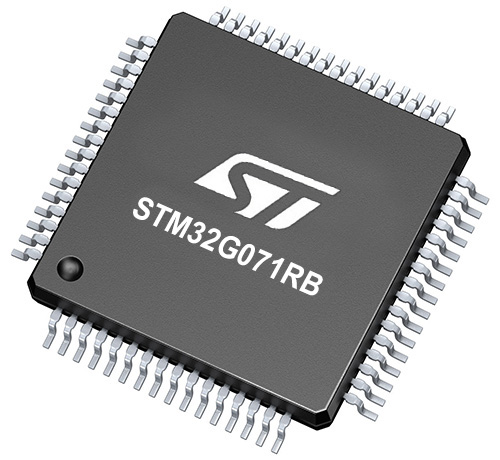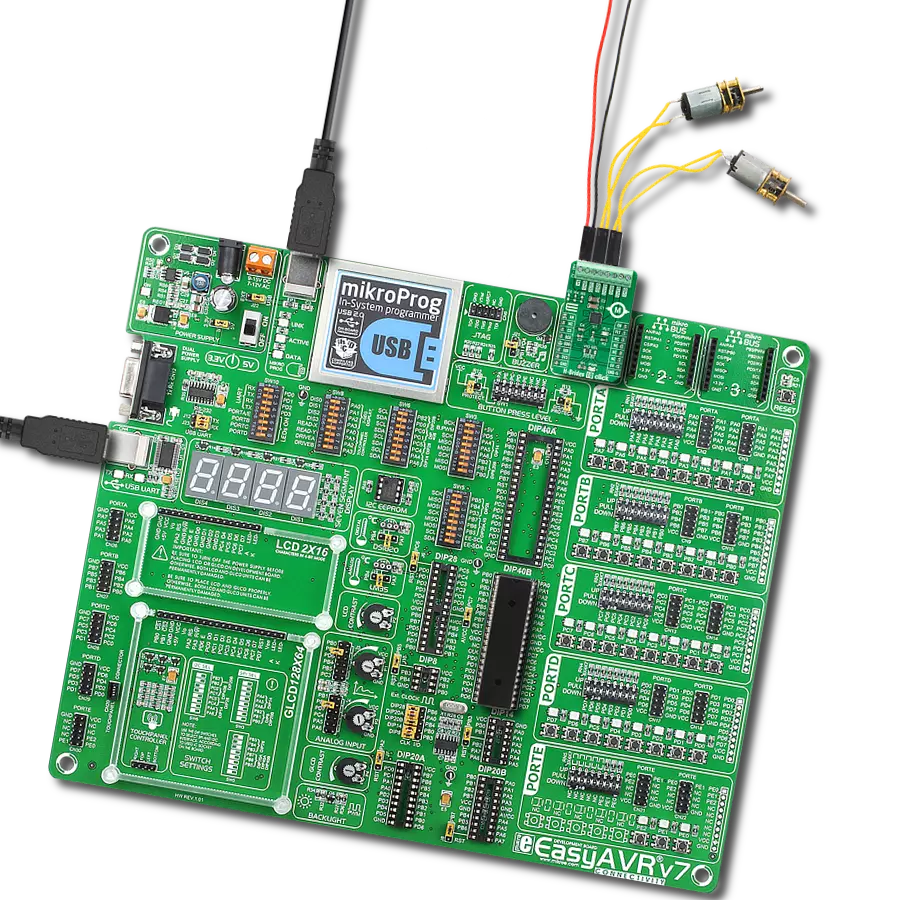Revolutionize your engineering project with tailored motor control solutions; unleash more than one DC motor with this solution!
A
A
Hardware Overview
How does it work?
H-Bridge 9 Click is based on the L99UDL01, a half-bridge driver PWM configurable and current-regulated from STMicroelectronics. The device contains six MOSFET half-bridge outputs and protection and diagnostic functions designed to improve safety and simplify the design. As a complete solution, this Click board™ replaces several separate motor drivers along with their associated analog and passive components, offering at the same time a more sophisticated functionality. The L99UDL01 can enter four different operating modes to control the working sequence: Normal mode, Sleep mode, Emergency override mode, and Standby mode as its default operation. In the Sleep mode, no-active circuitry is supplied, where logic is initialized but not operational. There is no function present in either mode to minimize the current consumption. Only wake-up circuitry is active in the Standby mode. Also, an emergency mode represents a crash override mechanism that will interrupt any current actuation command in progress and drive outputs
according to the programmed values in the command and configuration registers. Benefits are further enhanced by PWM control of the output current and sophisticated diagnostic functions that detect over-currents, line breaks, and short circuits to the battery and ground. The load-integrity tests can also be performed without activating the load. Also, programmable current limiting allows users to reduce the load, thereby increasing reliability. The output MOSFETs are fully protected with low RDS(ON) values, increasing energy efficiency and facilitating thermal management. The L99UDL01 communicates with MCU using the standard SPI serial interface with a maximum frequency of 4MHz, supporting the most common SPI mode, SPI Mode 0. It also features an interrupt function labeled as DO and routed to the INT pin of the mikroBUS™ socket that provides the host processor with a real-time fault indication. Besides an interrupt pin, Enable pin labeled as ENO and routed to the PWM pin of the mikroBUS™ socket enables the output
functionality while held high and turns off the outputs when kept low. This pin can also be used to initiate an output timed actuation, based on programmed parameters, on a rising edge. The H-Bridge 9 Click supports an external power supply for the L99UDL01, which can be connected to the input terminal labeled as VS and should be within the range of 6V to 18V, while the DC motor coils can be connected to the terminals labeled from O1 to O6. These outputs are configured as switching drivers incorporating active re-circulation to minimize power dissipation. It also has over-current protection, under-current detection, and OFF-state diagnostics. This Click board™ can operate with either 3.3V or 5V logic voltage levels selected via the VCC SEL jumper. This way, both 3.3V and 5V capable MCUs can use the communication lines properly. However, the Click board™ comes equipped with a library containing easy-to-use functions and an example code that can be used, as a reference, for further development.
Features overview
Development board
Nucleo-64 with STM32G071RB MCU offers a cost-effective and adaptable platform for developers to explore new ideas and prototype their designs. This board harnesses the versatility of the STM32 microcontroller, enabling users to select the optimal balance of performance and power consumption for their projects. It accommodates the STM32 microcontroller in the LQFP64 package and includes essential components such as a user LED, which doubles as an ARDUINO® signal, alongside user and reset push-buttons, and a 32.768kHz crystal oscillator for precise timing operations. Designed with expansion and flexibility in mind, the Nucleo-64 board features an ARDUINO® Uno V3 expansion connector and ST morpho extension pin
headers, granting complete access to the STM32's I/Os for comprehensive project integration. Power supply options are adaptable, supporting ST-LINK USB VBUS or external power sources, ensuring adaptability in various development environments. The board also has an on-board ST-LINK debugger/programmer with USB re-enumeration capability, simplifying the programming and debugging process. Moreover, the board is designed to simplify advanced development with its external SMPS for efficient Vcore logic supply, support for USB Device full speed or USB SNK/UFP full speed, and built-in cryptographic features, enhancing both the power efficiency and security of projects. Additional connectivity is
provided through dedicated connectors for external SMPS experimentation, a USB connector for the ST-LINK, and a MIPI® debug connector, expanding the possibilities for hardware interfacing and experimentation. Developers will find extensive support through comprehensive free software libraries and examples, courtesy of the STM32Cube MCU Package. This, combined with compatibility with a wide array of Integrated Development Environments (IDEs), including IAR Embedded Workbench®, MDK-ARM, and STM32CubeIDE, ensures a smooth and efficient development experience, allowing users to fully leverage the capabilities of the Nucleo-64 board in their projects.
Microcontroller Overview
MCU Card / MCU

Architecture
ARM Cortex-M0
MCU Memory (KB)
128
Silicon Vendor
STMicroelectronics
Pin count
64
RAM (Bytes)
36864
You complete me!
Accessories
Click Shield for Nucleo-64 comes equipped with two proprietary mikroBUS™ sockets, allowing all the Click board™ devices to be interfaced with the STM32 Nucleo-64 board with no effort. This way, Mikroe allows its users to add any functionality from our ever-growing range of Click boards™, such as WiFi, GSM, GPS, Bluetooth, ZigBee, environmental sensors, LEDs, speech recognition, motor control, movement sensors, and many more. More than 1537 Click boards™, which can be stacked and integrated, are at your disposal. The STM32 Nucleo-64 boards are based on the microcontrollers in 64-pin packages, a 32-bit MCU with an ARM Cortex M4 processor operating at 84MHz, 512Kb Flash, and 96KB SRAM, divided into two regions where the top section represents the ST-Link/V2 debugger and programmer while the bottom section of the board is an actual development board. These boards are controlled and powered conveniently through a USB connection to program and efficiently debug the Nucleo-64 board out of the box, with an additional USB cable connected to the USB mini port on the board. Most of the STM32 microcontroller pins are brought to the IO pins on the left and right edge of the board, which are then connected to two existing mikroBUS™ sockets. This Click Shield also has several switches that perform functions such as selecting the logic levels of analog signals on mikroBUS™ sockets and selecting logic voltage levels of the mikroBUS™ sockets themselves. Besides, the user is offered the possibility of using any Click board™ with the help of existing bidirectional level-shifting voltage translators, regardless of whether the Click board™ operates at a 3.3V or 5V logic voltage level. Once you connect the STM32 Nucleo-64 board with our Click Shield for Nucleo-64, you can access hundreds of Click boards™, working with 3.3V or 5V logic voltage levels.
DC Gear Motor - 430RPM (3-6V) represents an all-in-one combination of a motor and gearbox, where the addition of gear leads to a reduction of motor speed while increasing the torque output. This gear motor has a spur gearbox, making it a highly reliable solution for applications with lower torque and speed requirements. The most critical parameters for gear motors are speed, torque, and efficiency, which are, in this case, 520RPM with no load and 430RPM at maximum efficiency, alongside a current of 60mA and a torque of 50g.cm. Rated for a 3-6V operational voltage range and clockwise/counterclockwise rotation direction, this motor represents an excellent solution for many functions initially performed by brushed DC motors in robotics, medical equipment, electric door locks, and much more.
Used MCU Pins
mikroBUS™ mapper
Take a closer look
Click board™ Schematic

Step by step
Project assembly
Track your results in real time
Application Output
1. Application Output - In Debug mode, the 'Application Output' window enables real-time data monitoring, offering direct insight into execution results. Ensure proper data display by configuring the environment correctly using the provided tutorial.

2. UART Terminal - Use the UART Terminal to monitor data transmission via a USB to UART converter, allowing direct communication between the Click board™ and your development system. Configure the baud rate and other serial settings according to your project's requirements to ensure proper functionality. For step-by-step setup instructions, refer to the provided tutorial.

3. Plot Output - The Plot feature offers a powerful way to visualize real-time sensor data, enabling trend analysis, debugging, and comparison of multiple data points. To set it up correctly, follow the provided tutorial, which includes a step-by-step example of using the Plot feature to display Click board™ readings. To use the Plot feature in your code, use the function: plot(*insert_graph_name*, variable_name);. This is a general format, and it is up to the user to replace 'insert_graph_name' with the actual graph name and 'variable_name' with the parameter to be displayed.

Software Support
Library Description
This library contains API for H-Bridge 9 Click driver.
Key functions:
hbridge9_write_register- This function writes a desired data to the selected registerhbridge9_read_register- This function reads a desired data from the selected registerhbridge9_send_actuation_pulse- This function sends an actuation pulse by toggling the ENO pin
Open Source
Code example
The complete application code and a ready-to-use project are available through the NECTO Studio Package Manager for direct installation in the NECTO Studio. The application code can also be found on the MIKROE GitHub account.
/*!
* @file main.c
* @brief HBridge9 Click example
*
* # Description
* This example demonstrates the use of H-Bridge 9 click board.
*
* The demo application is composed of two sections :
*
* ## Application Init
* Initializes the driver and performs the click default configuration which will
* set the OUT1 to LOW, OUT2 to HIGH polarity, and the runtime to 1000ms.
*
* ## Application Task
* Sends an actuation pulse every 5 seconds which will run the motor for a certain amount of time
* as set by default configuration.
*
* @note
* The Voltage should be supplied with 6 to 18V power supply.
* Make sure to use a motor that operates in the above voltage range.
*
* @author Stefan Filipovic
*
*/
#include "board.h"
#include "log.h"
#include "hbridge9.h"
static hbridge9_t hbridge9;
static log_t logger;
void application_init ( void )
{
log_cfg_t log_cfg; /**< Logger config object. */
hbridge9_cfg_t hbridge9_cfg; /**< Click config object. */
/**
* Logger initialization.
* Default baud rate: 115200
* Default log level: LOG_LEVEL_DEBUG
* @note If USB_UART_RX and USB_UART_TX
* are defined as HAL_PIN_NC, you will
* need to define them manually for log to work.
* See @b LOG_MAP_USB_UART macro definition for detailed explanation.
*/
LOG_MAP_USB_UART( log_cfg );
log_init( &logger, &log_cfg );
log_info( &logger, " Application Init " );
// Click initialization.
hbridge9_cfg_setup( &hbridge9_cfg );
HBRIDGE9_MAP_MIKROBUS( hbridge9_cfg, MIKROBUS_1 );
err_t init_flag = hbridge9_init( &hbridge9, &hbridge9_cfg );
if ( SPI_MASTER_ERROR == init_flag )
{
log_error( &logger, " Application Init Error. " );
log_info( &logger, " Please, run program again... " );
for ( ; ; );
}
init_flag = hbridge9_default_cfg ( &hbridge9 );
if ( HBRIDGE9_ERROR == init_flag )
{
log_error( &logger, " Default Config Error. " );
log_info( &logger, " Please, run program again... " );
for ( ; ; );
}
log_info( &logger, " Application Task " );
}
void application_task ( void )
{
hbridge9_send_actuation_pulse( &hbridge9 );
log_printf( &logger, " Actuation pulse has been sent. \r\n\n" );
Delay_ms( 5000 );
}
void main ( void )
{
application_init( );
for ( ; ; )
{
application_task( );
}
}
// ------------------------------------------------------------------------ END


































